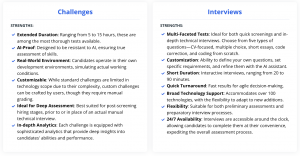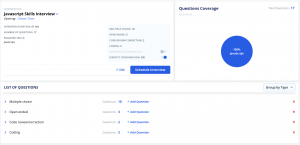Codeaid Adds Expert Mode to AI Interviewer for Customizable Automated Interviews
Expert Mode gives developers and recruiters full control over AI-led interviews—customizing questions, expected answers, and scoring for role-specific hiring.
Whether you're hiring for a mid-level backend developer or a senior front-end engineer, the tools now available in Expert Mode let you shape the interview to fit the role exactly. No more shoehorning questions into a generic format. You can closely collaborate with the AI to craft the perfect questions and be sure that the AI understands how to grade them.
“I’ve done a lot of technical hiring, and I always felt boxed in by overly automated platforms,” said Mladen Lazic, VP at Codeaid. “What we needed was a way to combine efficiency with the freedom and flexibility to tailor interviews to our specific requirements. Expert Mode gives us that flexibility. It works with us, not instead of us.”
More Customization. Less Guesswork.
With Expert Mode, users can:
- Write questions manually, or use built-in tools to generate a first draft and edit it
- Edit every part of a question before it goes live
- Establish answer guidelines to ensure consistent grading
- Preview how grading will work before a candidate ever sees the test
Beyond customization, Expert Mode also simplifies and accelerates the hiring process, offering practical advantages for both candidates and hiring teams:
- Asynchronous interviews: Candidates complete assessments on their own schedule, eliminating the need to coordinate calendars.
- Instant results: Submissions are processed immediately, allowing hiring teams to review outcomes without delay.
- Faster decision-making: Reduced turnaround time helps teams move quickly without compromising on quality.
- Broad technical support: Expert Mode works across 100+ supported technologies.
- Seamless integration: Built directly into Codeaid’s assessment platform, no additional setup required.
Flexible Interview Design for Every Hiring Workflow
Expert Mode isn't just about writing questions. It's about refining the entire process. Codeaid’s platform gives companies the freedom to start with a clean slate—selecting the exact role, skill level, and technologies they’re hiring for. From there, they can build their interview step-by-step, customizing as they go.
Key highlights:
- Choose from multiple formats: coding, multiple choice, open-ended, and code reviews
- Grade candidate responses against real examples
- Simulate how your criteria will affect scoring
- Track candidate behavior like response time and editing history
- Use built-in analytics to review overall performance and flag issues
This update supports two distinct workflows adapted for different users.
- Recruiters can launch interviews quickly using prebuilt tools and templates, then review the results through auto-scored reports—no technical expertise required.
- Engineers, on the other hand, have full control over the interview content and question flow, allowing them to craft assessments that align precisely with the role’s requirements.
By offering both levels of customization, Codeaid ensures that the hiring process works smoothly, whether it's driven by a recruiter, a hiring manager, or a senior developer.
Now Available
Expert Mode is now available to all Codeaid users across every subscription plan. The feature is built directly into the platform’s technical interview workflow, so there’s no need for a separate setup or onboarding process. In just a few minutes, hiring teams can begin creating customized coding assessments that reflect their real-world needs.
Whether you’re setting up quick screens for junior developers or crafting in-depth technical interviews for senior engineers, Expert Mode gives you the flexibility and control to build high-quality, role-specific evaluations from day one.
About Codeaid
Codeaid helps companies evaluate software engineers with practical, real-world tests. Its platform is designed for fast, flexible hiring with minimal bias. Whether teams need to screen junior developers or assess senior candidates for high-impact roles, Codeaid makes it possible to do it all in one place.
Ecaterina (Kate) Barari
Scopic
+1 774-234-6476
email us here
Visit us on social media:
LinkedIn
Instagram
Facebook
YouTube
X
Legal Disclaimer:
EIN Presswire provides this news content "as is" without warranty of any kind. We do not accept any responsibility or liability for the accuracy, content, images, videos, licenses, completeness, legality, or reliability of the information contained in this article. If you have any complaints or copyright issues related to this article, kindly contact the author above.
American haute couture documentary up for accolades
After Nearly 30 Years of Service, Greentrike CEO to Pass the Torch
The Democracy Center presents 'Breaking the Frame: Two Solo Shows on Art and Identity' from August 21–23
Więcej ważnych informacji
 Jedynka Newserii
Jedynka Newserii

 Jedynka Newserii
Jedynka Newserii

Konsument

Polacy nie korzystają z hossy trwającej na warszawskiej giełdzie. Na wzrostach zarabiają głównie inwestorzy zagraniczni
Od października 2022 roku na rynkach akcji trwa hossa, nie omija ona także warszawskiej giełdy. Mimo to inwestorzy indywidualni odpowiadają zaledwie za kilkanaście procent inwestycji, a o wzrostach decyduje i na nich zarabia głównie kapitał z zagranicy. Widać to również po napływach i odpływach do i z funduszy inwestycyjnych. Zdaniem Tomasza Koraba, prezesa EQUES Investment TFI, do przekonania Polaków do inwestowania na rodzimej giełdzie potrzeba zysków z akcji, informacji o tych zyskach docierającej do konsumentów oraz czasu.
Polityka
Obowiązek zapełniania magazynów gazu w UE przed sezonem zimowym ma zapewnić bezpieczeństwo dostaw. Wpłynie też na stabilizację cen

Unia Europejska przedłuży przepisy z 2022 roku dotyczące magazynowania gazu. Będą one obowiązywać do końca 2027 roku. Zobowiązują one państwa członkowskie do osiągnięcia określonego poziomu zapełnienia magazynów gazu przed sezonem zimowym. Magazyny gazu pokrywają 30 proc. zapotrzebowania Unii Europejskiej na niego w miesiącach zimowych. Nowe unijne przepisy mają zapewnić stabilne i przystępne cenowo dostawy.
Infrastruktura
Gminy zwlekają z uchwaleniem planów ogólnych zagospodarowania przestrzennego. Może to spowodować przesunięcie terminu ich wejścia w życie

Reforma systemu planowania i zagospodarowania przestrzennego rozpoczęła się we wrześniu 2023 roku wraz z wejściem w życie większości przepisów nowelizacji ustawy z 27 marca 2003 roku. Uwzględniono w niej plany ogólne gminy (POG) – nowe dokumenty planistyczne, za których przygotowanie mają odpowiadać samorządy. Rada Ministrów w kwietniu br. uchwaliła jednak ustawę o zmianie ustawy z 7 lipca 2023 roku, a jej celem jest zmiana terminu obowiązywania studiów uwarunkowań i kierunków zagospodarowania przestrzennego gmin na 30 czerwca 2026 roku. Wskazana data może nie być ostateczna z uwagi na to, że żadna z gmin nie uchwaliła jeszcze POG.
Partner serwisu
Szkolenia

Akademia Newserii
Akademia Newserii to projekt, w ramach którego najlepsi polscy dziennikarze biznesowi, giełdowi oraz lifestylowi, a także szkoleniowcy z wieloletnim doświadczeniem dzielą się swoją wiedzą nt. pracy z mediami.











.gif)

 |
| |
| |
|